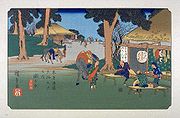
Sekigahara-juku
Encyclopedia

69 Stations of the Nakasendo
The are the rest areas along the Nakasendō, which ran from Nihonbashi in Edo to Sanjō Ōhashi in Kyoto. The route stretched approximately and was an alternate trade route to the Tōkaidō.-Stations of the Nakasendō:...
of the Nakasendō
Nakasendo
The , also called the , was one of the five routes of the Edo period, and one of the two that connected Edo to Kyoto in Japan. There were 69 stations between Edo and Kyoto, crossing through Musashi, Kōzuke, Shinano, Mino and Ōmi provinces...
. It is located in the present-day town of Sekigahara
Sekigahara, Gifu
is a town located in Fuwa District, Gifu Prefecture, Japan.As of July 2011, the town has an estimated population of 7,965. The total area is 49.29 km².In 1600, the Battle of Sekigahara took place here.-History:...
, Fuwa District
Fuwa District, Gifu
is a district located in Gifu, Japan.As of July 2011, the district has an estimated population of 36,426. The total area is 106.43 km²....
, Gifu Prefecture
Gifu Prefecture
is a prefecture located in the Chūbu region of central Japan. Its capital is the city of Gifu.Located in the center of Japan, it has long played an important part as the crossroads of Japan, connecting the east to the west through such routes as the Nakasendō...
, Japan
Japan
Japan is an island nation in East Asia. Located in the Pacific Ocean, it lies to the east of the Sea of Japan, China, North Korea, South Korea and Russia, stretching from the Sea of Okhotsk in the north to the East China Sea and Taiwan in the south...
.
History
Sekigahara-juku is convenient because it is located at the intersection of many roads. In addition to being part of the Nakasendō, it also is connected to the Hokkoku KaidōHokkoku Kaido
The was a highway in Japan during the Edo period. It was a secondary route, ranked below the Edo Five Routes in importance. Because it was developed for travelers going to Zenkō-ji, it was also called Zenkō-ji Kaidō . It stretched from the Nakasendō's Oiwake-juku to the Hokurikudō's Takada-shuku...
and the Ise Kaidō. However, its location has also been the site of many battles, including the Jinshin War
Jinshin War
The was a succession dispute in Japan which broke out in 672 following the death of Emperor Tenji. The name refers to the jinshin or ninth year of the sixty-year Jikkan Jūnishi calendrical cycle, corresponding to the Western year 673....
and the Battle of Sekigahara
Battle of Sekigahara
The , popularly known as the , was a decisive battle on October 21, 1600 which cleared the path to the Shogunate for Tokugawa Ieyasu...
.
In 1843, the post station had 1,389 residents and 269 buildings. Among the buildings, there was one honjin
Honjin
thumb|250px|The honjin at [[Inaba Kaidō]]'s [[Ōhara-shuku]]. is the Japanese word for an inn for government officials, generally located in post stations during the later part of the Edo period.-Evolution of Honjin:...
, one sub-honjin, and 33 hatago
Hatago
were Edo period lodgings for travelers at shukuba along the national highways, including the Edo Five Routes and the subroutes. In addition to a place to rest, hatago also offered meals and other foods to the travelers...
.
As the area around the former Sekigahara-juku remains a convenient and popular transportation hub, there are no ruins of the former post town to be found. However, because of all the battles in their area, there are many other ruins that can be seen.

